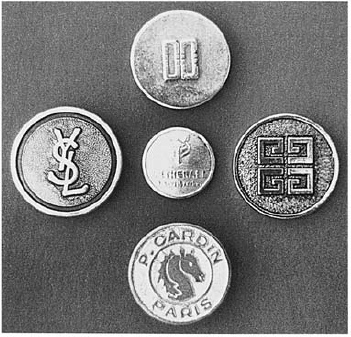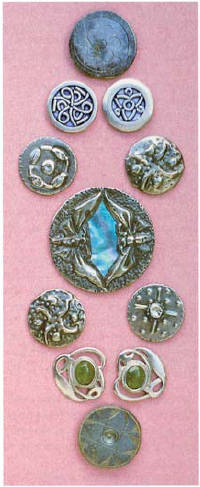Buttons (5 page)

Logo buttons: (top) Daks; (middle, left to right) Yves St Laurent, Wetherall, Givenchy; (bottom) Pierre Cardin.

A selection of twentieth-century buttons suitable for children, known by collectors as ‘realistics’.
Buttons designed specifically for children were a twentieth-century phenomenon. Before then all young children wore dresses and older children were put into smaller versions of their parents’ restrictive clothes. When practical clothes were designed for children buttons considered to be appealing to the young were made to go with them. Cute creatures predominated. With the advent of cinema, images of popular film and, later, television characters were used.

A selection of twentieth-century children’s buttons, including images from books, films and television.
Metals have been the staple material for button-making because of their hard-wearing properties and the wide scope they offer for decoration. Specific identification of the metal used in any button can aid in any cleaning necessary and may give an indication of its age. Always use the correct metal polish if deterioration due to the grime is likely to occur – but sparingly, with a cotton bud. Otherwise use a dry cloth and a soft brush. Great care must be taken in cleaning a two-piece or layered button as any moisture reaching the inside could do untold damage.
Aluminium
is frosty silver-coloured, very light in weight and resistant to tarnish, but subject to oxidation bloom. It was first refined in quantity in the middle of the nineteenth century but, as it was expensive, it was used sparingly in decorative work. There was a short vogue for its use in button-making at the end of the nineteenth century.
Brass
is an alloy of copper and zinc. It has been very widely used in button-making as a base for stamped or engraved designs, and for gilding or enamel work.
Bronze
is a brownish alloy of copper with up to one-third tin. Bronze buttons may be among metal detectorists’ finds.
Copper
is a pure, reddish-brown metal. It was used for dandies buttons in the eighteenth century. It made a resurgence in the Arts and Crafts period.

A selection of brass buttons from the nineteenth and twentieth centuries.

A selection of copper buttons. (Top) Stamped Art Nouveau style; (middle) eighteenth-century dandy; (bottom) hand-worked fretted.

Gold buttons. Those in the outer ring are marked 9ct. The centre one with pearl inset is marked 18ct.

Pewter buttons. (Top and bottom buttons) Metal-detector finds. (Second row) Craft-made English pewter, c. 1990. (Third and fifth rows) Various craft-worked. (Middle) Art Nouveau style with pearl inset. (Sixth row) Liberty Pewter, c. 1990.

Silver buttons. (Top row: first, second, fourth and fifth; and bottom row: first and fifth) Hallmarked London 1992, made by Iain Young, button designer for Jean Muir and others. (Top centre) London 1810, by P. & W. Bateman. (Middle row, left to right) Birmingham 1904; Birmingham 1903; London 1990, stylised design of the authors’ initials executed by Ken Vowles of Newent Silver; Birmingham 1903; London 1923. (Bottom row, left to right) See top row; Birmingham 1900; London 1780, John Rich; Birmingham 1894; see top row.
Gold
is soft in its pure form so is used in an alloy with a harder metal. The quantity of the gold is identified by the carat rating, pure gold being 24 carats. Gold buttons have been melted down or converted into jewellery, but twentieth-century gentlemen’s waistcoat buttons can be found.
Iron
in its pure form is a heavy metal, silvery-white in colour, that oxidises easily to form rust. Consequently it is unsuitable for use as a button surface. Before the middle of the eighteenth century iron shanks were widely used, with pewter and other metals forming the button top, hence many such buttons are found shankless because the iron has corroded. Iron and its compounds respond to a magnet.
Lead
is a soft, bluish-grey, heavy pure metal that has been used in sew-through button form as a weight, sewn originally into the hems of cloaks and dresses, but latterly in curtains. Once these weights have been used it is impossible to tell a modern one from its hundred-year-old counterpart. Lead and its compounds are toxic.
Pewter
was originally made from a mix of tin and lead, giving a softish metal with a deep grey sheen. As it was strong, durable and cheap it formed the most common metal for button-making until more attractive, comparable alternatives were produced in the middle of the eighteenth century. Pewter was used again during the Arts and Crafts period. In the twentieth century pewter has been made from an alloy of tin, copper and antimony, making it harder and whiter in appearance but not toxic. Liberty’s of London sold a range of jewellery, including buttons, in the 1990s, marked ‘Liberty Pewter’.
Silver
is frequently used with other metals to give it added hardness. It has been used in button-making for centuries. Much can be recognised and dated from the hallmark. Unmarked buttons can be chemically tested for their silver content, but dating is difficult as many recasts of early examples have been made.
Steel
is an alloy of iron and the non-metallic element carbon. Steel made with a high carbon content, as in the eighteenth century, has a very high resistance to rust and maintains its polished brilliance. In the nineteenth century less carbon was used and the buttons were much more susceptible to damage.
Tin
is a silvery-white pure metal, resistant to corrosion and taking a good, high polish. In button-making it was used extensively in the early half of the twentieth century for plating iron or steel sheeting. Rust is frequently seen on tinplate as a result of the deterioration of the iron content of the lower layer.
In identifying the particular metal used in a button it is as well to bear in mind that the aim of its manufacturer was to make the product appear to be of the highest possible quality at the most economic cost. To this end, fused finishes may be added to a base metal to enhance the appearance.
Cut steel
is the term used to describe the addition of steel studs to the face of a button to create the appearance of marcasite. It has an appeal that has spanned centuries. The studs of the earliest cut steel buttons, those made in the area around Woodstock, Oxfordshire, in the seventeenth and eighteenth centuries, were actually screwed into place rather than riveted. They are rare. The Woodstock trade ended in the middle of the eighteenth century when less expensive riveted steel buttons were produced in Birmingham. The first examples of these have studs roughly arranged on a solid plate, sometimes of brass, each stud being individually polished from steel made in a high cementation process. Later the baseplate was cut to a pattern, making a button of much lighter weight. The next development was for the cut steel pattern to be stamped from a sheet of solid steel and one or two rivets used to attach it to the button. In the nineteenth century the face of the button was stamped out of one piece of metal. The steel was of poorer quality and easily rusted. No foolproof method of permanent restoration of cut steel buttons has been found. Some hallmarked silver buttons were produced with a very similar design punched into the face. To eliminate the problems of rust and of sharp metal damaging the cloth, pressed glass buttons were lustred to resemble cut steel. Traditional court-dress steel buttons have a heavy baseplate with a mix of riveted and moulded studs on the surface. In the twentieth century buttons with the appearance of cut steel were made from metalised plastics.